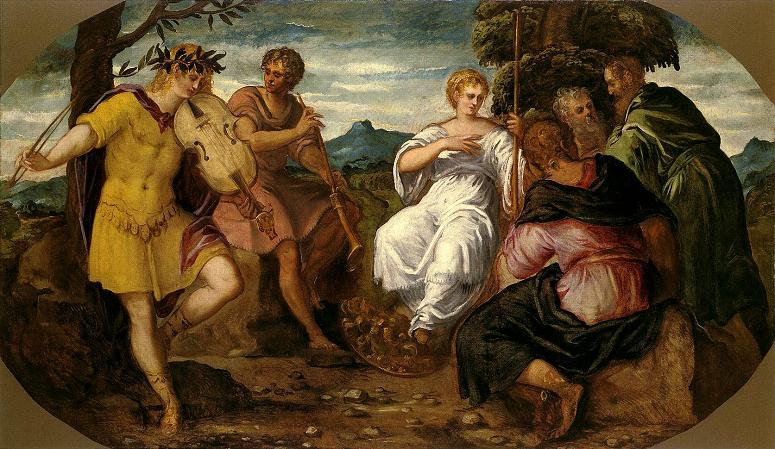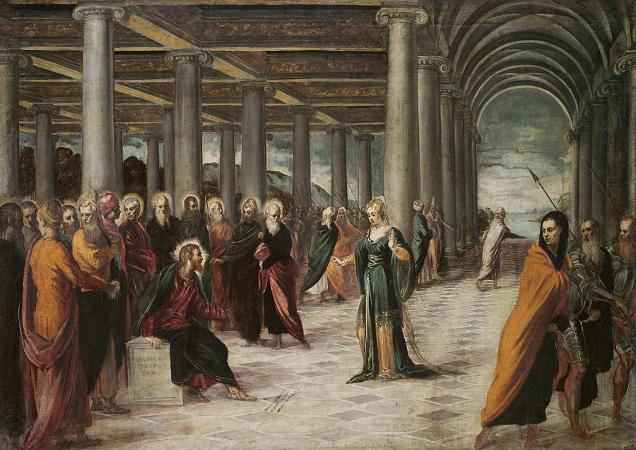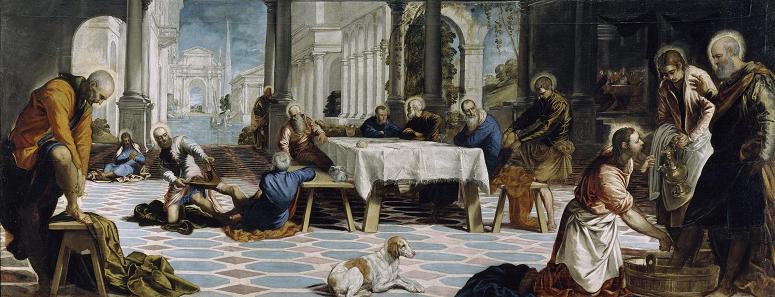Jacopo Tintoretto (1518 - 1594). Tintoretto was an Italian painter and a notable exponent of the Venetian school. The Last Supper in the church of San Giorgio Maggiore in Venice is considered his maserpeice. It depicts the biblical scene of Jesus' last meal with his disciples before his crucifixion, but Tintoretto's interpretation is known for its dynamic composition, dramatic lighting, and innovative perspective. The The Miracle of the Slave in the Gallerie dell'Accademia in Venice depicts a miracle performed by Saint Mark, the patron saint of Venice, in which he causes a slave to be miraculously freed from his chains. His contemporaries both admired and criticized the speed with which he painted, and the unprecedented boldness of his brushwork. For his phenomenal energy in painting he was termed Il Furioso. His work is characterised by his muscular figures, dramatic gestures and bold use of perspective, in the Mannerist style. In his youth, Tintoretto was also known as Jacopo Robusti, as his father had defended the gates of Padua in a way that others called robust against the imperial troops during the War of the League of Cambrai. His real name, Comin, as discovered by Miguel Falomir of the Museo del Prado in Madrid, was made public on the occasion of the retrospective of Tintoretto at the Prado in 2007. The name Comin translates to the spice cumin in the Venetian language. Tintoretto was born in Venice in 1518, as the eldest of 21 children. His father, Giovanni, was a dyer, or tintore; hence the son got the nickname of Tintoretto, little dyer, or dyer's boy. The family was believed to have originated from Brescia, in Lombardy, then part of the Republic of Venice. Older studies gave the Tuscan town of Lucca as the origin of the family. In childhood Jacopo, a born painter, began daubing on the dyer's walls; his father, noticing his bent, took him to the studio of Titian to see how far he could be trained as an artist. This was supposedly around 1533, when Titian was over 40 years of age. Tintoretto had only been ten days in the studio when Titian sent him home for good, because the great master observed some very spirited drawings, which he learned to be the production of Tintoretto; it is inferred that he became at once jealous of so promising a student. This, however, is mere conjecture; and perhaps it may be fairer to suppose that the drawings exhibited so much independence of manner that Titian judged that young Jacopo, although he might become a painter, would never be properly a pupil. From this time forward the two always remained upon distant terms, though Tintoretto being indeed a professed and ardent admirer of Titian, but never a friend, and Titian and his adherents turned a cold shoulder to him. There was also active disparagement, but it passed unnoticed by Tintoretto. The latter sought no further teaching, but studied on his own account with laborious zeal; he lived poorly, collecting casts, bas-reliefs etc., and practising with their aid. His noble conception of art and his high personal ambition were both evidenced in the inscription which he placed over his studio Il disegno di Michelangelo ed il colorito di Tiziano. He studied more especially from models of Michelangelo's Dawn, Noon, Twilight and Night, and became expert in modelling in wax and clay method which afterwards stood him in good stead in working out the arrangement of his pictures. The models were sometimes taken from dead subjects dissected or studied in anatomy schools; some were draped, others nude, and Tintoretto was to suspend them in a wooden or cardboard box, with an aperture for a candle. Now and afterwards he very frequently worked by night as well as by day. The young painter Andrea Schiavone, four years Tintoretto's junior, was much in his company. Tintoretto helped Schiavone at no charge with wall-paintings; and in many subsequent instances he also worked for nothing, and thus succeeded in obtaining commissions. The two earliest mural paintings of Tintoretto, done, like others, for next to no pay, are said to have been Belshazzar's Feast and a Cavalry Fight. These have both long since perished, as have all his frescoes, early or later. The first work of his to attract some considerable notice was a portrait-group of himself and his brother, the latter playing a guitar, with a nocturnal effect; this has also been lost.
more...














